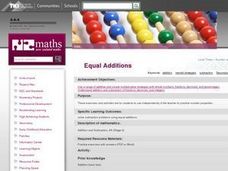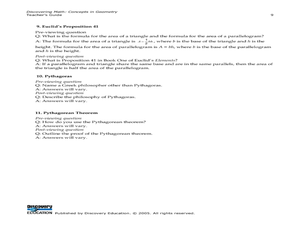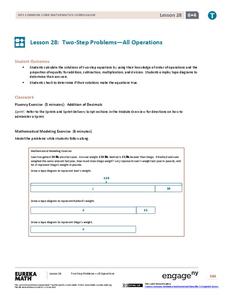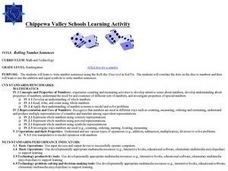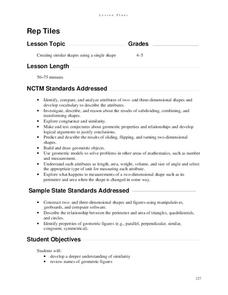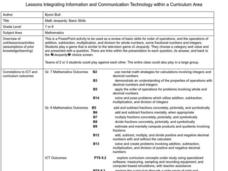Curated OER
Equal Additions
Pupils explore the relationships between numbers through the use of "equal addition" and "equal subtraction." Through the use of number sense, they are able to computer addition and subtraction problems mentally. Individually, students...
Curated OER
Discovering Math: Computation
Middle schoolers add, subtract, multiply, and divide rational numbers. They find the square and the cube of numbers. They create a game incorporating computation on rational numbers. Everyone works together to write and evaluate...
Curated OER
Discovering Math: Concepts in Geometry
Middle and high schoolers explore the concept of proving the Pythagorean Theorem. They research proofs of the Pythagorean Theorem. Pupils create posters of proofs, and research Greek mathematicians.
EngageNY
Two-Step Problems—All Operations
Step 1: Use the resource. Step 2: Watch your class become experts in solving two-step problems. Scholars learn to solve two-step word problems in context. They use tape diagrams and algebraic techniques to break the problem into two,...
EngageNY
Solving Inequalities
Do properties of equations hold true for inequalities? Teach solving inequalities through the theme of properties. Your class discovers that the multiplication property of equality doesn't hold true for inequalities when multiplying by a...
EngageNY
Triangle Congruency Proofs (part 1)
Can they put it all together? Ninth graders apply what they know about proofs and triangle congruence to complete these proofs. These proofs go beyond the basic triangle congruence proofs and use various properties, theorems, and...
Curated OER
Rolling Number Sentences
Budding mathematicians investigate how to write number sentences using the Roll-the-Dice tool in "Kid Pix". They correlate the dots on the dice to numbers and then learn to use the addition and equal symbols to write number sentences....
EngageNY
A Surprising Boost from Geometry
Working with imaginary numbers — this is where it gets complex! After exploring the graph of complex numbers, learners simplify them using addition, subtraction, and multiplication.
Curated OER
Adding and Subtracting Polynomials
For use with a TI-nspire calculator, this lesson focuses on adding and subtracting polynomials. Learners use calculator to add and subtract polynomials using both the vertical method horizontal methods. A class discussion follows the...
EngageNY
Graphing the Logarithmic Function
Teach collaboration and communication skills in addition to graphing logarithmic functions. Scholars in different groups graph different logarithmic functions by hand using provided coordinate points. These graphs provide the basis for...
Curated OER
Lesson Design Protocol: Add and Subtract
Addition and subtraction are studied in this math lesson. Upper graders add and subtract whole numbers up to 1,000 with and without regrouping.
Improving Measurement and Geometry in Elementary Schools
Rep Tiles
In addition to the catchy title, this lesson plan provides upper graders an opportunity to more closely scrutinize the attributes of plane figures. In particular, they focus on the similarity of different shapes. Both whole-class and...
Curated OER
Smiling at Two Digit Multiplication!
How do I solve a two-digit multiplication problem? Your class tackles this question by walking through problem solving methods. They first investigates and applies traditional multiplication methods, and they then compare those with...
Curated OER
"The Grapes of Math" by Gregg Tang
Students practice mental addition and use the associative and commutative properties of addition to solve problems.
Curated OER
Commutative Property
First graders investigate the Commutative Property of Addition. It is introduced using models such as students, counters, balances and dominoes. They discover the order of the numbers in an addition sentence does not change the result...
Curated OER
Multiplicative and Additive Identity
Middle schoolers explore the identity properties of multiplication and of addition. They answer riddles that have to do with the identity properties and observe the teacher explanation of each property as they are modeled on the board. ...
Curated OER
Identity and Equality Properties: Pages 37-43
In this math worksheet, students use a list of mathematical properties in order to justify their evaluations. Students name multiplicative inverses and properties illustrated in 13 numbers and statements.
Curated OER
Addition/Subtraction Strategies
Third graders recall all their addition and subtraction facts to 20. They use the relevant number strategy with whole numbers. Students are taught place value in relation to decimals, and identify 'which decimal is larger.' They...
Curated OER
Math Jeopardy: Basic Skills
Students play a PowerPoint activity to be used as a review of basic skills for order of operations, and the operations of addition, subtraction, multiplication, and division for whole numbers, some fractional numbers and integers....
Curated OER
Solving Equations Using the Addition And Multiplication Principles
In this math worksheet, learners solve the problems using the addition and multiplication properties of equality. Then the solutions are found for the variables.
Curated OER
Properties of Operations
Eighth graders use the order of operation correctly. For this algebra lesson, 8th graders solve integers using the order of operation. They apply the commutative as well as the associate property to solve problems correctly.
Curated OER
Solving Inequalities By Using Addition And Subtraction
Seventh graders solve inequalities using addition and subtraction. They write number sentences based on word problems.
Curated OER
Addition, Subtraction, and More Multiplication with Radicals: Extra Practice 36
In this math worksheet, students use the distributive property to complete computation with radicals. Students multiply pairs of binomials that have the square root sign in each pair.
Curated OER
Spill the Beans
Students explore the meaning of a fact family. In this Math lesson, students work in small groups to create their own fact family based on color of beans. The beans are colored and represent a given value. Students discover the...


